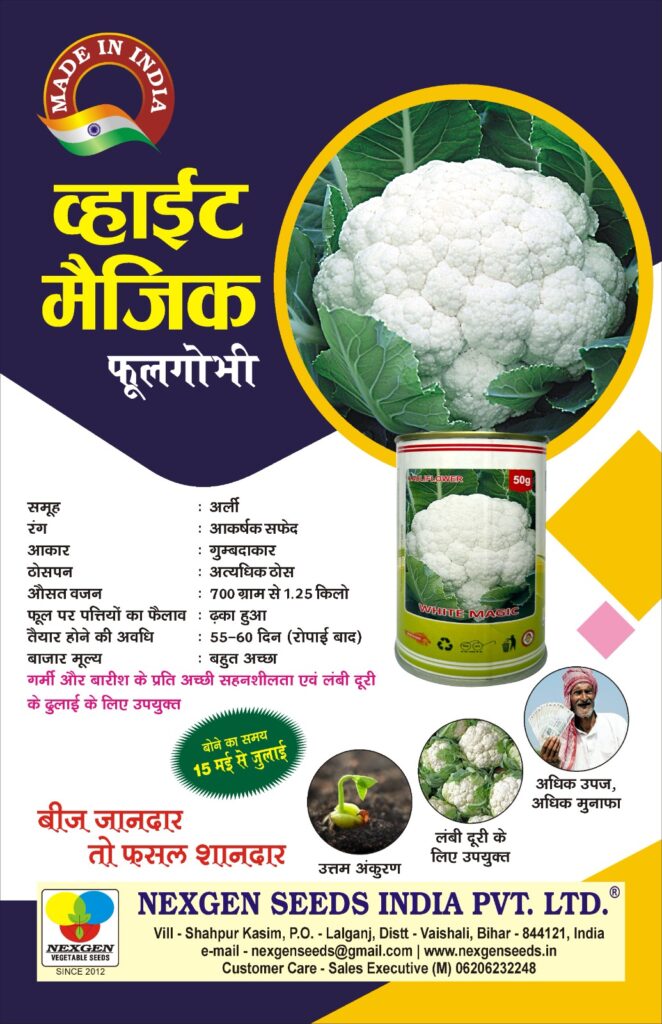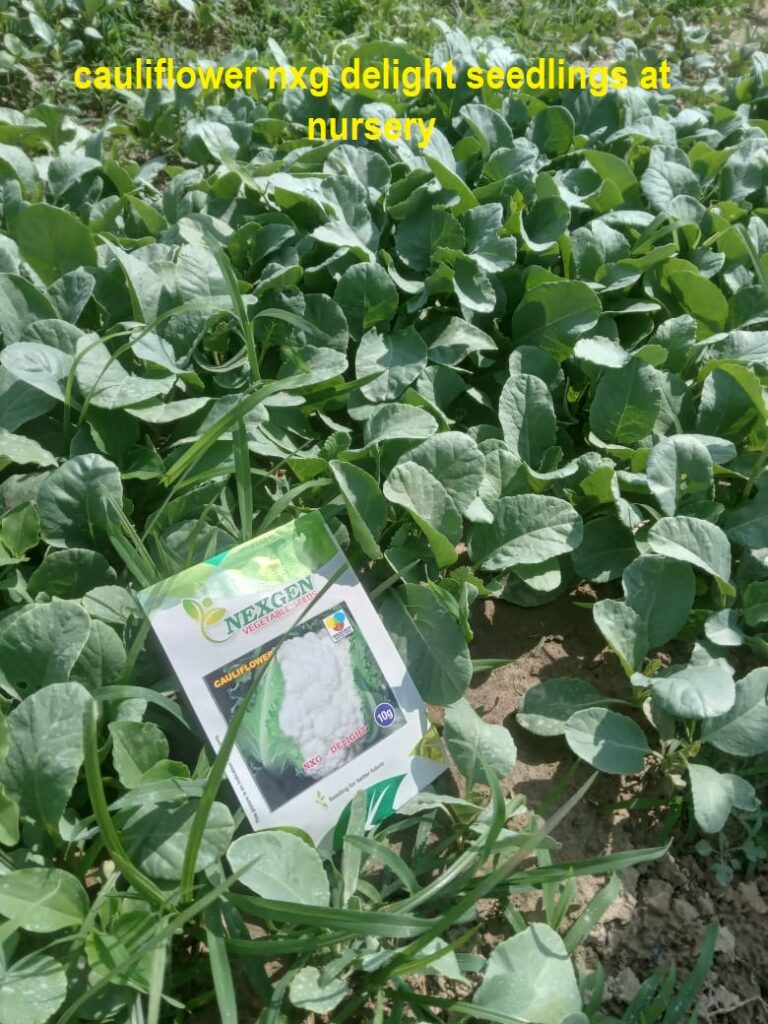Introduction:
Are you a gardening enthusiast with limited space? Don’t worry! Growing cauliflower in containers is a fantastic way to enjoy fresh, homegrown produce even if you have a small garden or no garden at all. In this blog, we will explore the wonderful world of cauliflower cultivation in containers and highlight the top cauliflower varieties from the NXG series, including NXG Delight, NXG White Lady, NXG 172, NXG 911, NXG White Magic, NXG 1033, NXG Tejas, NXG Karishma, NXG Anmol and NXG Hansa. Let’s dive in and discover how you can cultivate these delicious and nutritious vegetables right at home.

- Selecting the Right Container:
Choosing the right container is crucial for successful cauliflower cultivation. Opt for containers that are at least 18 inches deep, ensuring ample space for the cauliflower’s root system to grow. Additionally, containers with a diameter of 12-16 inches are ideal, providing enough room for the cauliflower plant to spread out and develop.
- Quality Soil and Drainage:
Cauliflower thrives in well-draining soil. Prepare a suitable potting mix by combining equal parts of compost, peat moss, and perlite. This mixture guarantees adequate moisture retention while preventing waterlogging. Remember to use high-quality soil to provide the necessary nutrients for your cauliflower plants.
- Ideal Growing Conditions:
Cauliflower prefers cool weather and requires a minimum of six hours of sunlight each day. Place your container in a spot where it will receive the maximum amount of sunlight. If you live in a region with scorching summers, consider providing partial shade during the hottest part of the day to protect the plants from excessive heat.
- Watering and Fertilization:
Maintaining consistent moisture levels is essential for cauliflower plants. Water your container-grown cauliflower regularly, ensuring the soil remains evenly moist. Avoid overwatering, that leads to root rot at cauliflower plants. Applying a balanced organic fertilizer every three weeks will provide the necessary nutrients for healthy growth and abundant harvests.
- Pests and Disease Control:
Cauliflower is susceptible to various pests and diseases, including aphids, caterpillars, and fungal infections. Regularly inspect your cauliflower plants for any signs of infestation or diseases. Implementing organic pest control methods such as neem oil or insecticidal soaps can help keep these issues at bay and preserve the health of your cauliflower plants.
- Harvesting and Storage:
The NXG series offers a wide range of cauliflower varieties, each with its unique characteristics and maturity dates. Harvesting time can vary depending on the variety, but generally, cauliflower heads are ready to be harvested when they reach a desirable size and are still firm and compact. Cut the heads carefully using a sharp knife, leaving a few outer leaves intact for protection. After harvesting, store your cauliflower in a cool, dry place or refrigerate it to maintain freshness.
Conclusion:
Growing cauliflower in containers is an excellent option for gardeners with limited space. By following these tips and utilizing the top cauliflower varieties from the NXG series, such as NXG Delight, NXG White Lady, NXG Tejas, NXG Karishma, NXG Anmol, NXG 172, NXG 911, NXG White Magic, NXG 1033, and NX G Hansa, you can enjoy a bountiful harvest of delicious and nutritious cauliflower right at home.
Remember to choose the right container size, provide well-draining soil, and ensure your cauliflower plants receive adequate sunlight. Consistent watering and fertilization will promote healthy growth, while implementing organic pest control methods will protect your plants from common pests and diseases.
When it comes time to harvest, each variety in the NXG series has its own unique characteristics and maturity dates. Be sure to monitor your cauliflower heads closely and harvest them when they reach the desired size, remaining firm and compact. With a sharp knife, carefully cut the heads, leaving a few outer leaves intact for protection.
After harvesting, it’s important to store your cauliflower properly to maintain its freshness. You can store it in a cool, dry place or refrigerate it to extend its shelf life. This way, you can enjoy the flavours of your homegrown cauliflower in various culinary creations.
Whether you’re a seasoned gardener or a beginner, growing cauliflower in containers is an accessible and rewarding experience. With the top cauliflower varieties from the NXG series, you can experiment with different flavours, textures, and colours while reaping the nutritional benefits of these versatile vegetables.
So, roll up your sleeves, gather your containers, and start your cauliflower-growing journey. With these tips and the incredible NXG series varieties like NXG Delight, NXG White Lady, NXG Tejas, NXG Karishma, NXG Anmol, NXG 172, NXG 911, NXG White Magic, NXG 1033, and NXG Hansa, your container garden will be flourishing with healthy and delicious cauliflower in no time.
Happy gardening and bon appétit! We hope you found this guide on growing cauliflower in containers helpful and inspiring. Remember, the NXG series offers exceptional cauliflower varieties that are specifically bred for their taste, texture, and performance. By selecting varieties such as NXG Delight, NXG White Lady, NXG Tejas, NXG Karishma, NXG Anmol, NXG 172, NXG 911, NXG White Magic, NXG 1033, and NXG Hansa, you can elevate your gardening experience and enjoy a diverse range of cauliflower flavours and appearances.
Experimenting with different varieties not only adds excitement to your garden but also allows you to explore new culinary possibilities. From creamy white heads to vibrant purple and orange varieties, the NXG series offers a rainbow of cauliflower options to suit your taste and aesthetic preferences.
Don’t forget to share your gardening journey with others. Whether it’s through social media, a gardening community, or simply sharing your harvest with friends and neighbours, spreading the joy of homegrown cauliflower can inspire others to embark on their own container gardening adventures.
As you embark on your cauliflower-growing journey, remember to be patient and enjoy the process. Gardening is a rewarding and therapeutic activity that connects us with nature and the food we consume. By cultivating cauliflower in containers, you not only maximize your available space but also contribute to a sustainable and healthier lifestyle.
So, gather your containers, select your favorite NXG series varieties, and get ready to experience the joy of growing cauliflower in your own home. May your harvests be plentiful and your culinary creations delicious!
यह भी पढ़ें: गोभी उगाने के लिए जानिए ये 15 अहम बातें !
Happy gardening! Remember to document your journey as you grow cauliflower in containers. Blog about your experiences, share photos of your thriving plants, and provide updates on the progress of your cauliflower heads. Sharing your insights and tips with others in the gardening community can be incredibly valuable and inspiring.
Here are a few additional tips and tricks to ensure a successful and bountiful harvest of cauliflower in containers:
- Crop Rotation: If you plan to grow cauliflower in containers year after year, it’s essential to practice crop rotation. Avoid planting cauliflower or any other brassica family crops in the same container or location for consecutive growing seasons. This helps prevent the buildup of pests and diseases specific to brassicas.
- Thinning and Spacing: To ensure proper airflow and encourage healthy growth, thin out your cauliflower seedlings once they have a few true leaves. Leave only the strongest and healthiest plants in each container, spacing them according to the specific variety’s recommendations.
- Temperature and Season Extension: Cauliflower thrives in cool temperatures, but extreme heat can cause the plants to bolt and produce small, underdeveloped heads. Consider using shade cloth or providing some shade during hot summer days to protect your cauliflower from scorching heat.
- Succession Planting: To enjoy a continuous harvest of cauliflower throughout the growing season, stagger your planting. Start new seeds or transplant seedlings every few weeks, ensuring a steady supply of fresh cauliflower.
- Companion Planting: Some companion plants can help deter pests or attract beneficial insects to your cauliflower containers. Consider planting herbs like dill, thyme, or mint, which can repel certain pests. Marigolds and nasturtiums also serve as natural pest deterrents and add a beautiful touch to your container garden.
- Soil Amendments: Incorporate organic matter, such as compost or well-rotted manure, into the soil before planting. This enriches the soil and provides essential nutrients for healthy cauliflower growth. Additionally, applying a layer of mulch around the base of your plants helps retain moisture and suppresses weed growth.
By implementing these additional tips and tricks, you can enhance your container gardening experience and increase your chances of a successful cauliflower harvest.
Remember, growing cauliflower in containers offers a world of possibilities, even in limited spaces. The NXG series varieties like NXG Delight, NXG White Lady, NXG Tejas, NXG Karishma, NXG Anmol, NXG 172, NXG 911, NXG White Magic, NXG 1033, and NXG Hansa are bred to provide outstanding flavour and yield, making them excellent choices for your container garden.
Now, armed with knowledge and inspiration, it’s time to get started on your cauliflower-growing adventure. Happy gardening and enjoy the delicious rewards of your labour!
यह भी पढ़ें: फूलगोभी उत्पादन करने वाले भारतीय 10 राज्यों की शीर्ष

Cauliflower in Containers: Overcoming Top 10 Challenges for a Bountiful Harvest
Introduction:
Growing cauliflower in containers offers a convenient and rewarding way to cultivate this versatile vegetable. However, like any gardening endeavour, it comes with its fair share of challenges. In this article, we will explore the top 10 problems faced by gardeners when growing cauliflower in containers and provide effective solutions for each issue. We will also highlight the top cauliflower varieties from the NXG series, including NXG Delight, NXG White Lady, NXG Tejas, NXG Karishma, NXG Anmol, NXG 172, NXG 911, NXG White Magic, NXG 1033, and NXG Hansa.
- Limited Space:
Problem: One of the primary challenges of container gardening is the limited space available for plant growth, which can hinder the development of cauliflower heads.
Solution: Opt for compact cauliflower varieties, such as NXG Delight and NXG White Lady, which are specifically bred to thrive in containers. These varieties have a more compact growth habit, making them ideal for confined spaces.
- Insufficient Sunlight:
Problem: Cauliflower requires at least six hours of direct sunlight daily to grow and develop properly. Inadequate sunlight can result in weak plants and poor-quality heads.
Solution: Place your containers in the sunniest spot available, such as a south-facing balcony or patio. Consider using reflective materials or light-reflecting films to maximize sunlight exposure for your plants.
- Inconsistent Watering:
Problem: Inconsistent watering can lead to uneven growth, poor head formation, and increased susceptibility to diseases.
Solution: Ensure your cauliflower plants receive consistent moisture by checking the soil regularly. Water deeply when the top inch of soil feels dry, but avoid overwatering, as it can cause root rot. Consider using self-watering containers or installing a drip irrigation system for more efficient watering.
- Nutrient Deficiency:
Problem: Cauliflower is a heavy feeder and requires adequate nutrients to develop healthy heads. Nutrient deficiencies can result in stunted growth and low-quality cauliflower.
Solution: Prior to planting, enrich the potting soil with well-balanced organic compost or slow-release fertilizers. Additionally, supplement with a balanced liquid fertilizer every two to three weeks during the growing season to ensure your plants receive essential nutrients.
- Pests and Diseases:
Problem: Common pests such as aphids, cabbage worms, and diseases like clubroot and powdery mildew can affect cauliflower plants, leading to reduced yields and plant damage.
Solution: Implement preventive measures such as regularly inspecting plants for pests, promoting good air circulation, and maintaining proper sanitation. Consider using organic pest control methods like handpicking pests, applying neem oil, or introducing beneficial insects like ladybugs or lacewings to control pest populations.
- Temperature Extremes:
Problem: Cauliflower is a cool-season crop and is sensitive to temperature extremes. High temperatures can cause premature bolting (flowering) while low temperatures can stunt growth and delay maturity.
Solution: Choose cauliflower varieties that are suitable for your climate and time you’re planting accordingly. Provide shade during hot summer days and use row covers or cloches to protect plants from frost during colder months.
- Improper pH Level:
Problem: Cauliflower prefers a slightly acidic soil pH ranging from 6.0 to 7.0. An improper pH level can affect nutrient availability and hinder plant growth.
Solution: Test the soil pH using a pH testing kit or send a sample to a local agricultural extension service. If the pH is too high, amend the soil with organic matter like compost or peat moss to lower the pH. Conversely, if the pH is too low, add agricultural lime to raise it to the desired range.
- Overcrowding:
Problem: Planting cauliflower too close together can lead to overcrowding, which restricts air circulation and provides an ideal environment for diseases to thrive.
Solution: Follow the recommended spacing guidelines for the specific cauliflower variety you are growing. This ensures adequate air circulation and prevents the spread of diseases. Thin out any overcrowded plants to maintain proper spacing.
- Weeds Competition:
Problem: Weeds compete with cauliflower plants for nutrients, water, and sunlight, which can negatively impact their growth and development.
Solution: Regularly inspect your containers for weeds and promptly remove them. Apply a layer of organic mulch, such as straw or wood chips, around your cauliflower plants to suppress weed growth and conserve soil moisture.
- Timing and Succession Planting:
Problem: Planting all cauliflower seedlings at once can result in a glut of harvest, making it challenging to consume or preserve the entire yield.
Solution: Practice succession planting by sowing cauliflower seeds at staggered intervals, a few weeks apart. This ensures a continuous harvest throughout the growing season, allowing you to enjoy fresh cauliflower without overwhelming quantities.
Conclusion:
By addressing these top 10 challenges faced by gardeners when growing cauliflower in containers, you can optimize your chances for a bountiful harvest. Remember to choose suitable cauliflower varieties from the NXG series, such as NXG Delight, NXG White Lady, NXG Tejas, NXG Karishma, NXG Anmol, NXG 172, NXG 911, NXG White Magic, NXG 1033, and NXG Hansa, which are specifically bred for container gardening. With proper care, attention to detail, and a little creativity, you can enjoy a thriving cauliflower garden right at your fingertips. Happy gardening!
Read More : Maximizing Yield with Cauliflower Seeds in India

